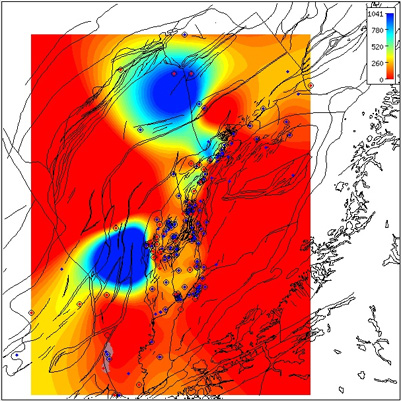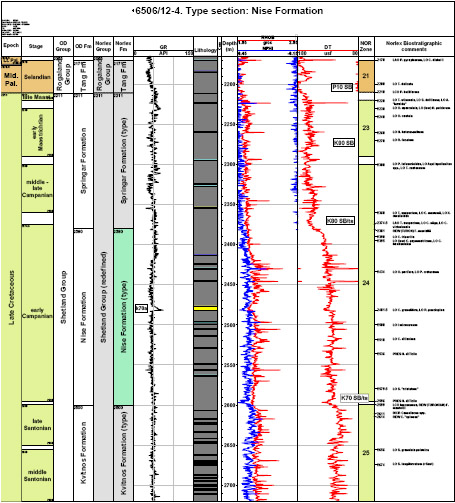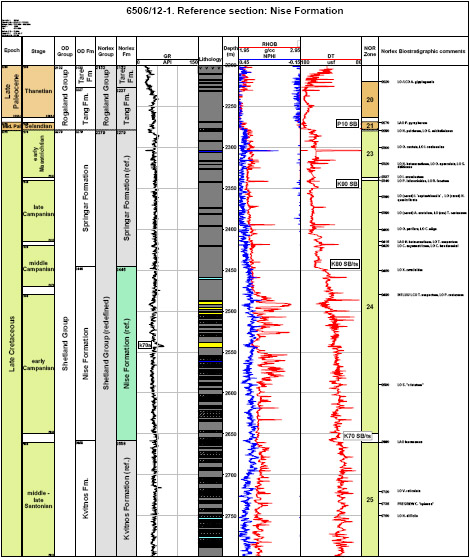Nise Formation
Shetland Group
Introduction
The term Nise Formation was introduced by Dalland et al. (1988) for a thick
unit of predominantly non-calcareous marine mudstones that lay between the
Kvitnos and
Springar Formations developed throughout the Norwegian Sea region. Two new sandstone
members are defined within this formation: the Spekkhogger Member, an interval of
Campanian sandstones found in the Vøring Basin and the Nebbhval Member, a unit with a
similar stratigraphic age developed in the Vestfjorden Basin.
Name
English/ Norwegian and any previous names: None
Derivatio nominis: The name Nise comes from the Norwegian for the harbour
porpoise species Phocoena phocoena. This is a small, widespread, toothed whale (up to 2m
long) found in both temperate coastal waters in the North Atlantic and colder latitudes of the
North Sea, Norwegian Sea and westerly parts of the Barents Sea.
Lithology
The Nise Formation mainly consists of mudstones with subordinate siltstones,
sandstones and occasional carbonate stringers. The mudstones are light - medium grey,
occasionally green-grey or brown-grey, predominantly soft, plastic, occasionally blocky-firm,
non to weakly calcareous, silty or occasionally sandy, and occasional grade to siltstone. The
siltstones are argillaceous, soft-firm, friable to loose with pyrite and glauconite. The sandstone
interbeds are light brown, very fine to fine, occasionally medium or coarse, clear quartz, sub-
angular to sub-rounded grains, moderate to well sorted, predominantly loose, occasionally
calcite cemented with glauconite, mica and pyrite. The limestone stringers are white-grey,
soft, occasionally argillaceous, micritic and occasionally sandy and the subordinate dolomite
stringers are orange brown to light brown and firm to hard.
Sample depository
Palynological preparations (organic matter depository)
Type well 6506/12-4: 17 slides (dc and 2 swc) from samples covering the interval 2381m dc –
2599m (Stratlab preparations) available at the Norwegian Petroleum Directorate.
Reference well 6506/12-1: 35 slides (dc and 1 swc at 2582m) from samples covering the
interval 2450m – 2645m (Stratlab, RRI and OD preparations) available at the Norwegian
Petroleum Directorate.
Core photographs
No cores were taken in the Nise Formation in either the designated type 6506/12-4 or
reference 6506/12-1 wells.
Thickness
The Nise Formation has a thickness range of 5.5m - 1041m.

Regional isochore of the Nise Formation thickness in the Norwegian Sea based on released well data.
The isochore map is generated from Norlex data using thin plate splines (thickness constrained to original
range).
Thicknesses in metres.
Circled wells contain both top and base horizons.
The red wells have Norlex biostratigraphy. Click for large version.
Interactive Function:
Note that this map is only a regional interpretation and the user can generate more specific, local area
isochore maps
interactively within Norlex using the link below.
Interactive Norlex isochore map for the Nise Formation
|
Geographical distribution
The Nise Formation is generally extensive and widely distributed in the Norwegian Sea area,
notably in the Vøring Basin e.g. 6706/11-1 (1041m) and on the Halten Dønna Terrace
The thickest depo-centres are associated with the thick sandstones dominated sequences of the
Spekkhogger Member in wells within the Vøring Basin e.g. 6707/10-1 where the formation is
typically greater than 1000m thick. The formation is either thin or absent along parts of the
the Nordland Ridge or on local highs e.g. 6507/8-5 (5.5m), a truncated sequence located on
the Omega Horst, Sør High. The Nise Formation is typically 100m - 200m thick in wells on
the Halten – Dønna Terrace areas and more thinly developed on the Trøndelags Platform.
Occurrences of formation tops in wells
Type well
Well name: 6506/12-4
WGS84 coordinates: N 65°12'46.97, E 06°43'30.37 (figure 2)
UTM coordinates: 7234298.14 N 393591.29 E
UTM zone: 32
Drilling operator name: Den norske stats oljeselskap a.s. (Statoil a.s.)
Completion date: 13.08.1985
Status: P & A
Interval of type section (m) & thickness in type well (m):
2600m to 2380m and 220m thickness.

Click for large version (PDF)
Reference well
Well name: 6506/12-1
WGS84 coordinates: N 65°10'07.58, E 06°43'44.07 (figure 2)
UTM coordinates: 7229359.52 N 393591.68 E
UTM zone: 32
Drilling operator name: Den norske stats oljeselskap a.s. (Statoil a.s.)
Completion date: 06.02.1985
Status: P & A
Interval of reference section (m) & thickness in reference well (m): 2658m -
2446m, 212m thickness.

Click for large version (PDF)
Upper and lower boundaries
Upper boundary
The top of the Nise Formation and boundary with the overlying Springar Formation is
usually
defined by a prominent downward increase in sonic velocity. There is a minor associated
increase in density but typically no gamma ray response at this level.
Lower boundary
The base of the Nise Formation with that of the underlying Kvitnos Formation is considered
to reflect a down section increase in the calcareous nature of the mudstones.
This is normally marked on logs by a downward increase in sonic velocity and density values.
There is no apparent associated response on gamma-ray logs.
Well log characteristics
In mudstone dominated sequences of the Halten and Dønna Terrace areas, the stepwise shift
in average sonic velocity values allows the Kvitnos, Nise and Springar Formations to be
distinguished relatively easily. These trends probably reflect compaction trends within broad,
marine mudstones depositional units. The boundaries may reflect periods of still-stand or
regionally transgressive events since the formation boundaries appear to be broadly
synchronous within the area.
Also within these mudstone dominated sequences developed on the margins of the Vøring
Basin, there is a subtle upward decrease in average gamma ray values near the base of this
formation that probably reflects the input of sandstone into the basin. Towards the top of the
formation, but not coincident with the velocity change defining the upper boundary, is an
increase in gamma-ray values e.g. 6506/12-1, 2475m that probably reflects the decrease in
basinward sandstone deposition, close to the early /middle Campanian boundary.
A prominent high gamma ray spike within the formation is identified as a regionally
correlatable tuff horizon (k70a) e.g. 6506/12-1, 2542m.
Type seismic section
Biostratigraphy
[Figure]
Biostratigraphic data is generally poor in the type well 6506/12-4. However, the base of the
Nise Formation appears to be close to the Santonian/Campanian boundary being closely
associated with the (down-section) influx of the planktonic bivalve Inoceramus typical of a
Santonian age (Zone 25). This influx is probably related to the downward development of
more calcareous mudstones. Support is provided by the earliest Campanian dinocyst marker
LO Spongodinium ‘cristatum’ in the basal part of the formatio
The upper boundary of this formation appears to be close to the early/middle Campanian
boundary being between between the dinocyst markers LO Callaiosphaeridium asymetricum
and LAO Trithyrodinium suspectum.
The top abundant record (LAO) Trithyrodinium suspectum is the key marker near the top of
the Nise Formation.
Age
Late Cretaceous, latest Santonian – middle Campanian (revised this study).
Dalland et al. (1988) had a similar but more broader Santonian – Campanian age range.
Correlation
The Nise Formation is laterally equivalent to the Kyrre Formation developed in the Shetland
Group of the northern North Sea and Magne Formation (formerly upper Hod formation) of
the North Sea Chalk Group.
Depositional environment
The Nise Formation was generally deposited in a deep, bathyal palaeoenvironment, under
restricted water circulation developed in response to a deep but narrow seaway between
Norway and Greenland connecting the area to the Atlantic oceanic realm (Gradstein et al.,
1999).
Deep water, non-calcareous agglutinated foraminifera (DWAF) dominate the microfaunas
with similar in composition to those of the North Atlantic. Diatoms bloom at certain levels.
Remarks
The Nise Formation represents deposition within the upper part of K4 sequence of Swiecicki
et al. (1998), K85 and K90 of Vergara et al. (2001) and the K70 sequence of Færseth and
Lien (2001).
References
Dalland, A., Worsley, D. and Ofstad, K. 1988. A lithostratigraphic scheme for the Mesozoic
and Cenozoic succession offshore Mid and Northern Norway. Bulletin of the Norwegian
Petroleum Directorate, Bulletin No. 4, 1-65.
Færseth, R. and Lien, T. 2002 Cretaceous evolution in the Norwegian Sea – a period
characterized by tectonic quiescence. Marine and Petroleum Geology, 19, 1005 –1027.
Gradstein, F., Kaminski, M.A. and Agterberg, F.P. 1999. Biostratigraphy and
paleoceanography of the Cretaceous seaway between Norway and Greenland. Earth-Science
Reviews, 46, 27-98.
Swiecicki, T., Gibbs, P.B., Farrow, G.E. and Coward, M.P. 1998. A tectonostratigraphic
framework for the Mid-Norway region. Marine and Petroloeum Geology, 15, 245-276.
Vergara, L., Wreglesworth, I., Trayfoot, M., Richardsen, G. 2001. The distribution of
Cretaceous and Paleocene deep-water reservoirs in the Norwegian Sea basins. Petroleum
Geoscience, 7, 395-408.



